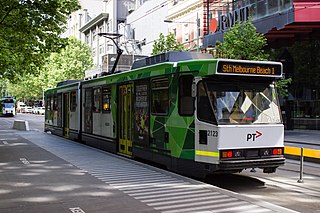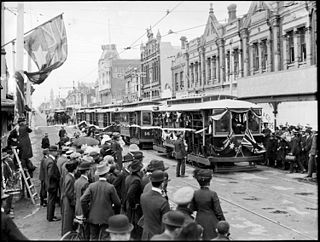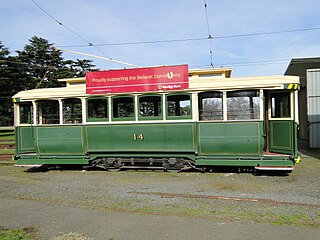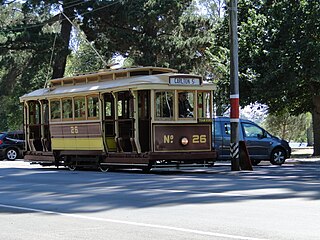Related Research Articles

Melbourne tram route 16 is operated by Yarra Trams on the Melbourne tram network from Melbourne University to Kew. The 20.2 kilometre route is operated out of Malvern depot with Z and D1 class trams.

Melbourne tram route 1 is operated by Yarra Trams on the Melbourne tram network from East Coburg to South Melbourne Beach. The 13.2-kilometre (8.2 mi) route is operated out of Brunswick depot with Z and B class trams.

Melbourne tram route 19 is operated by Yarra Trams on the Melbourne tram network from Coburg North to Flinders Street station. The 10.2 kilometre route is operated out of Brunswick depot with B and D2 class trams.

The W-class trams are a family of electric trams built by the Melbourne & Metropolitan Tramways Board (MMTB) between 1923 and 1956. Over the 33 years of production, 752 vehicles spanning 12 sub-classes were constructed, the majority at the MMTB's Preston Workshops.

The Prahran and Malvern Tramways Trust (PMTT) was a former tram operator in Melbourne, Australia. The trust was formed in 1907, with its first line operating in 1910. Its functions were taken over by the Melbourne & Metropolitan Tramways Board in 1920.

The earliest trams in Australia operated in the latter decades of the 19th century, hauled by horses or "steam tram motors". At the turn of the 20th century, propulsion almost universally turned to electrification, although cable trams lingered in Melbourne. In cities and towns that had trams, they were a major part of public transport assets.

The Ballarat Tramway Museum is an operating tramway museum, located in Ballarat, Victoria, Australia. The museum is run by volunteers and has a fleet of trams which operate on part of the original horse tramway around Lake Wendouree and the Botanical Gardens. It has a large research collection, archive of information and more than 3,500 items about the Ballarat tramways. The trams in Ballarat operated on a large network through the city from 1887 until 1971.

The E-class was a group of 10 trams built by Duncan & Fraser, Adelaide, for the Prahran & Malvern Tramways Trust (P&MTT) in 1914, numbered 36 to 45. Number 36 was converted to a different form by the P&MTT c. 1916, and was later designated D-class. All retained their fleet numbers when passed to the Melbourne & Metropolitan Tramways Board (M&MTB) after it took over the P&MTT on 2 February 1920, and they were designated E-class sometime after October 1921. By late 1923, together with other all M&MTB drop-end-and-centre Maximum Traction trams, they were re-classed as C-class trams. The 22E Maximum Traction trucks were of JG Brill design, although manufactured by Brush in England.

The J-class was a class of twenty trams built by the Meadowbank Manufacturing Company, Sydney for the Prahran & Malvern Tramways Trust (PMTT). All passed to the Melbourne & Metropolitan Tramways Board on 2 February 1920 when it took over the PMTT becoming the J-class retaining their running numbers.
The L-class was a class of six trams ordered from James Moore & Sons by the Prahran & Malvern Tramways Trust (PMTT). However, by the time they were delivered in 1921, the PMTT had been taken over by the Melbourne & Metropolitan Tramways Board (MMTB).

The M-class was a class of 17 trams built by Duncan & Fraser, Adelaide for the Hawthorn Tramways Trust (HTT) as numbers 1 to 10, and 33 to 39. All passed to the Melbourne & Metropolitan Tramways Board on 2 February 1920 when it took over the Municipal Tramway Trusts, becoming the M-class and being renumbered 107 to 116, and 183 to 189.

The P-class was a class of eight trams built by Duncan & Fraser, Adelaide for the Hawthorn Tramway Trust (HTT) as numbers 25 to 32. All passed to the Melbourne & Metropolitan Tramways Board on 2 February 1920 when it took over the HTT becoming the P-class and being renumbered 131 to 138.
The Q-class was a class of 24 trams built by the Melbourne & Metropolitan Tramways Board (MMTB). They were built as part of the MMTB's plan to quickly increase the size of its fleet at its Holden Street Workshops. Twenty were rebuilt for use on all night services and in this role they travelled across the network.
The S-class was a class of 18 trams built by Duncan & Fraser, Adelaide for the Melbourne, Brunswick & Coburg Tramways Trust (MBCTT). The first 12 entered service in 1916, numbered 1 to 12. All passed to the Melbourne & Metropolitan Tramways Board (MMTB) on 2 February 1920 when it took over the MBCTT, becoming the S-class and renumbered 154-165.
The X-class was a class of two Birney trams imported from United States manufacturers JG Brill Company and St Louis Car Company by the Melbourne & Metropolitan Tramways Board. In June 1924 both entered service from Hawthorn depot on the Power Street to Hawthorn Bridge service. In 1928 both were transferred to Glenhuntly depot to operate the Point Ormond route.
The X1-class was a class of ten trams built by the Melbourne & Metropolitan Tramways Board. Developed from the X-class, they differed in having four doors. They were initially allocated to Glenhuntly and Hawthorn depots. Six were transferred to the isolated Footscray network In June 1928 with the other four following in June 1929.
The X2-class was a class of six trams built by the Melbourne & Metropolitan Tramways Board. Developed from the X1-class, they differed in having larger wheels, angled windshields and only two doors.
The Y1-class was a class of four trams built by the Melbourne & Metropolitan Tramways Board built as a modified version of the Y-class to trial one man operation. Initially used on East and West Preston routes from Collins Street, from 1934 they were transferred to the Toorak line. From 1936 they were used on Burwood services from Camberwell depot. In 1933, 613 was used on Victorian Railways' Sandringham railway station to Black Rock line.
The Melbourne tram network began in 1884 with the construction of the Fairfield Horse Tramway. However, the purpose of the line was to increase land prices in the area, and it soon closed during the depression in 1890. The first genuine attempt to construct a tramway network was the construction of the Richmond cable tram line by the Melbourne Tramway & Omnibus Company in 1885. Over the next few years, 16 more cable tram lines were constructed, as well as numerous other horse tramways. The depression of the early 1890s slowed further expansion of the cable network. The first electric tram line was the Box Hill and Doncaster tramway which opened in 1889. This was a pioneering line in what was then the countryside and thus didn't receive much patronage. It closed in 1896. The next attempt at an electric tramway was Victorian Railways' St Kilda to Brighton line, which opened in 1906. Later that year, the North Melbourne Electric Tramway & Lighting Company opened lines to Essendon and Maribyrnong. Many local councils formed their own tramway trusts and built tramways within their own constituency. The most successful of these was the Prahran & Malvern Tramways Trust.
The Melbourne Tramcar Preservation Association is a tram preservation society in Haddon, Victoria, Australia.
References
- ↑ Cross, Norman; Budd, Dale; Wilson, Randall (1993). Destination City Melbourne's Electric Trams (5 ed.). Sydney: Transit Publishing Australia. p. 65. ISBN 0 909459 18 5.
- ↑ T Class Vicsig
- ↑ Melbourne & Metropolitan Tramways Board Board T Class No 180 Melbourne Tram Museum
- ↑ M&MTB T No 180 Tramway Museum Society of Victoria